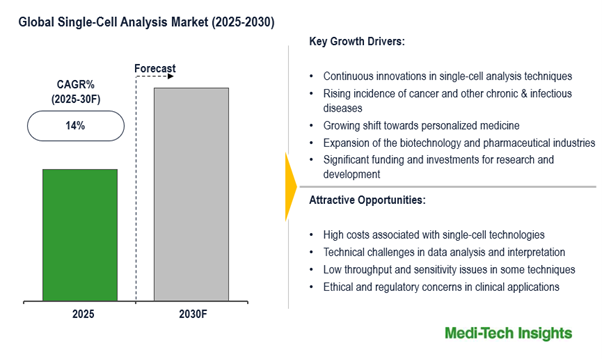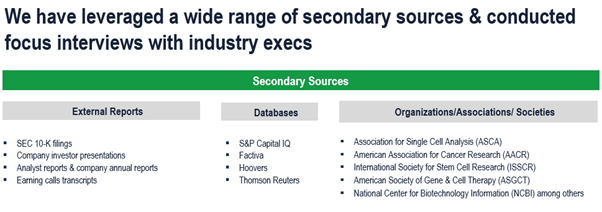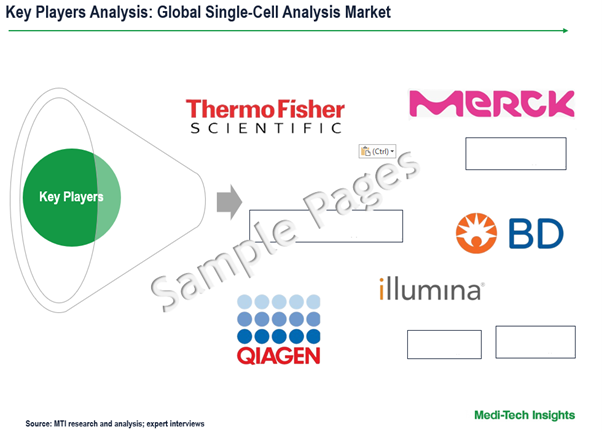
Global Single-Cell Analysis Market Size & Trends Report Segmented by Product (Consumables, Instruments), Cell Type (Human, Animal), Technique (Flow Cytometry, NGS), Application (Research, Medical), End User (Pharmaceutical, Biotechnology Companies) & Regional Forecast to 2030
The global single-cell analysis Market is expected to witness a growth rate of 14% in the next five years. Continuous innovations in single-cell analysis techniques; rising incidence of cancer and other chronic & infectious diseases; growing shift towards personalized medicine; expansion of the biotechnology and pharmaceutical industries; significant funding and investments for research and development from governments, private companies, and venture capitalists; growing applications in biomedical research; and collaborations between academic institutions, biotechnology companies, and pharmaceutical firms to accelerates the research and development process are some of the key factors driving the single-cell analysis market growth. To learn more about the research report, download a sample report.
Report Overview
Single-cell analysis is a technique used in biological and medical research to study individual cells at the molecular level. Unlike bulk analysis, which examines large cell populations, single-cell analysis reveals cellular heterogeneity by examining differences in gene expression, protein levels, and metabolic activity. It is crucial for understanding disease mechanisms, identifying rare cell populations, and advancing precision medicine. Technologies such as single-cell RNA sequencing (scRNA-seq), flow cytometry, and mass spectrometry enable high-resolution insights into cellular behavior. Applications span cancer research, immunology, neuroscience, and drug development, making single-cell analysis essential for innovations in diagnostics and targeted therapies.  Continuous innovations in single-cell analysis techniques to drive market growth
Continuous innovations in single-cell analysis techniques to drive market growth
Innovations in single-cell analysis, including NGS, microfluidics, and mass cytometry, drive market growth by enhancing precision, sensitivity, and throughput. These technologies uncover cellular heterogeneity and rare cell populations, improving diagnostics and personalized medicine. Reduced costs and complexity make them more accessible, expanding their use in oncology, immunology, and stem cell research. Growing applications attract investment and collaborations across academia, biotech, and pharma, fueling market expansion. As advancements continue, single-cell analysis accelerates scientific discovery, leading to breakthroughs in disease research and therapeutic development, reinforcing its critical role in the future of biomedical science.  Rising incidence of cancer and other chronic & infectious diseases to fuel market growth
Rising incidence of cancer and other chronic & infectious diseases to fuel market growth
The rising incidence of cancer and infectious diseases fuels demand for single-cell analysis, enhancing diagnostics and targeted therapies. According to the WHO in 2022, there were an estimated 20 million new cancer cases and 9.7 million deaths, and the cancer cases are expected to increase significantly due to aging populations, lifestyle changes, and environmental factors. Single-cell analysis uncovers tumor heterogeneity, identifying resistant cancer subpopulations and improving personalized medicine. It also aids infectious disease research by analyzing host-pathogen interactions, leading to better treatments and vaccines. Increased investment and innovation drive adoption by pharmaceutical, biotech, and academic institutions, expanding the market as precision medicine and advanced research become essential in disease management and therapeutic development.
Competitive Analysis
The global single-cell analysis market is marked by the presence of established and emerging market players such as Becton, Dickinson and Company; Danaher Corporation; Thermo Fisher Scientific, Inc.; Merck KGaA; Qiagen; 10x Genomics, Inc.; Standard BioTools Inc.; Promega Corporation; Illumina, Inc.; and Bio-Rad Laboratories, Inc.; among others. Some of the key strategies adopted by market players include new product development, strategic partnerships and collaborations, and geographic expansion.
Report Scope
| Report Scope | Details |
| Base Year Considered | 2024 |
| Historical Data | 2023 – 2024 |
| Forecast Period | 2025 – 2030 |
| Growth Rate | 14% |
| Market Drivers |
|
| Attractive Opportunities |
|
| Segment Scope | Product, Cell Type, Technique, Application, End User |
| Regional Scope |
|
| Key Companies Mapped | Becton, Dickinson and Company; Danaher Corporation; Thermo Fisher Scientific, Inc.; Merck KGaA; Qiagen; 10x Genomics, Inc.; Standard BioTools Inc.; Promega Corporation; Illumina, Inc.; and Bio-Rad Laboratories, Inc. among others |
| Report Highlights | Market Size & Forecast, Growth Drivers & Restraints, Trends, Competitive Analysis |
Market Segmentation
This report by Medi-Tech Insights provides the size of the global single-cell analysis market at the regional- and country-level from 2023 to 2030. The report further segments the market based on product, cell type, technique, application, end user.
- Market Size & Forecast (2023-2030), By Product, USD Million
- Consumables
- Beads
- Microplates
- Reagents
- Assay kits
- Immunoassays
- Cell-based assays
- Other Consumables
- Instruments
- Flow Cytometers
- NGS Systems
- PCR Instruments
- Spectrophotometers
- Cell Counters
- Microscopes
- HCS Systems
- Microarrays
- Other Instruments
- Consumables
- Market Size & Forecast (2023-2030), By Cell Type, USD Million
- Human Cell
- Animal Cell
- Microbial Cell
- Market Size & Forecast (2023-2030), By Technique, USD Million
- Flow Cytometry
- Next-generation Sequencing
- Polymerase Chain Reaction
- Microscopy
- Mass Spectrometry
- Others
- Market Size & Forecast (2023-2030), By Application, USD Million
- Research Applications
- Cancer Research
- Immunology Research
- Neurology Research
- Stem Cell Research
- Other Research Applications
- Medical Applications
- Non-invasive Prenatal Diagnosis
- In Vitro Fertilization
- Circulating Tumor Cell Detection
- Other Medical Applications
- Research Applications
- Market Size & Forecast (2023-2030), By End User, USD Million
- Biotechnology & Pharmaceutical Companies
- Academic & Research Laboratories
- Hospitals & Diagnostic Laboratories
- Cell banks & IVF Centers
- Other End Users
- Others
- Market Size & Forecast (2023-2030), By Region, USD Million
- North America
- US
- Canada
- Europe
- UK
- Germany
- France
- Italy
- Spain
- Rest of Europe
- Asia Pacific
- China
- India
- Japan
- Rest of Asia Pacific
- Latin America
- Middle East & Africa
- North America
Key Strategic Questions Addressed
- What is the market size & forecast of the single-cell analysis market?
- What are historical, present, and forecasted market shares and growth rates of various segments and sub-segments of the single-cell analysis market?
- What are the key trends defining the market?
- What are the major factors impacting the market?
- What are the opportunities prevailing in the market?
- Which region has the highest share in the global market? Which region is expected to witness the highest growth rate in the next 5 years?
- Who are the major players operating in the market?
- What are the key strategies adopted by players?
- Introduction
- Introduction
- Market Scope
- Market Definition
- Segments Covered
- Regional Segmentation
- Research Timeframe
- Currency Considered
- Study Limitations
- Stakeholders
- List of Abbreviations
- Key Conferences and Events (2025-2026)
- Research Methodology
- Secondary Research
- Primary Research
- Market Estimation
- Bottom-Up Approach
- Top-Down Approach
- Market Forecasting
- Executive Summary
- Single-Cell Analysis Market Snapshot (2025-2030)
- Segment Overview
- Regional Snapshot
- Competitive Insights
- Market Overview
- Market Dynamics
- Drivers
- Continuous innovations in single-cell analysis techniques
- Rising incidence of cancer and other chronic & infectious diseases
- Growing shift towards personalized medicine
- Expansion of the biotechnology and pharmaceutical industries
- Significant funding and investments for research and development
- Growing applications in biomedical research
- Collaborations between academic institutions, biotechnology and pharmaceutical companies
- Restraints
- High costs associated with single-cell technologies
- Technical challenges in data analysis and interpretation
- Low throughput and sensitivity issues in some techniques
- Ethical and regulatory concerns in clinical applications
- Opportunities
- Expansion of single-cell analysis in precision medicine
- Growing applications in infectious disease research
- Emerging market potential in developing regions
- Development of high-throughput and cost-effective solutions
- Key Market Trends
- Advancements in single-cell multi-omics
- Microfluidics and droplet-based technologies
- AI and machine learning integration
- Unmet Market Needs
- Industry Speaks
- Drivers
- Market Dynamics
- Global Single-Cell Analysis Market Size & Forecast (2023-2030), By Product, USD Million
- Introduction
- Consumables
- Beads
- Microplates
- Reagents
- Assay kits
- Immunoassays
- Cell-based assays
- Other Consumables
- Instruments
- Flow Cytometers
- NGS Systems
- PCR Instruments
- Spectrophotometers
- Cell Counters
- Microscopes
- HCS Systems
- Microarrays
- Other Instruments
- Global Single-Cell Analysis Market Size & Forecast (2023-2030), By Cell Type, USD Million
- Introduction
- Human Cell
- Animal Cell
- Microbial Cell
- Global Single-Cell Analysis Market Size & Forecast (2023-2030), By Technique, USD Million
- Introduction
- Flow Cytometry
- Next-generation Sequencing
- Polymerase Chain Reaction
- Microscopy
- Mass Spectrometry
- Others
- Global Single-Cell Analysis Market Size & Forecast (2023-2030), By Application, USD Million
- Introduction
- Research Applications
- Cancer Research
- Immunology Research
- Neurology Research
- Stem Cell Research
- Other Research Applications
- Medical Applications
- Non-invasive Prenatal Diagnosis
- In Vitro Fertilization
- Circulating Tumor Cell Detection
- Other Medical Applications
- Global Single-Cell Analysis Market Size & Forecast (2023-2030), By End User, USD Million
- Introduction
- Biotechnology & Pharmaceutical Companies
- Academic & Research Laboratories
- Hospitals & Diagnostic Laboratories
- Cell banks & IVF Centers
- Other End Users
- Global Single-Cell Analysis Market Size & Forecast (2023-2030), By Region, USD Million
- Introduction
- North America Single-Cell Analysis Market Size & Forecast (2023-2030), By Country, USD Million
- US
- Market Size & Forecast, By Product (USD Million)
- Market Size & Forecast, By Cell Type (USD Million)
- Market Size & Forecast, By Technique (USD Million)
- Market Size & Forecast, By Application (USD Million)
- Market Size & Forecast, By End User (USD Million)
- Canada
- Market Size & Forecast, By Product (USD Million)
- Market Size & Forecast, By Cell Type (USD Million)
- Market Size & Forecast, By Technique (USD Million)
- Market Size & Forecast, By Application (USD Million)
- Market Size & Forecast, By End User (USD Million)
- US
-
- Europe Single-Cell Analysis Market Size & Forecast (2023-2030), By Country, USD Million
- UK
- Market Size & Forecast, By Product (USD Million)
- Market Size & Forecast, By Cell Type (USD Million)
- Market Size & Forecast, By Technique (USD Million)
- Market Size & Forecast, By Application (USD Million)
- Market Size & Forecast, By End User (USD Million)
- Germany
- Market Size & Forecast, By Product (USD Million)
- Market Size & Forecast, By Cell Type (USD Million)
- Market Size & Forecast, By Technique (USD Million)
- Market Size & Forecast, By Application (USD Million)
- Market Size & Forecast, By End User (USD Million)
- France
- Market Size & Forecast, By Product (USD Million)
- Market Size & Forecast, By Cell Type (USD Million)
- Market Size & Forecast, By Technique (USD Million)
- Market Size & Forecast, By Application (USD Million)
- Market Size & Forecast, By End User (USD Million)
- Italy
- Market Size & Forecast, By Product (USD Million)
- Market Size & Forecast, By Cell Type (USD Million)
- Market Size & Forecast, By Technique (USD Million)
- Market Size & Forecast, By Application (USD Million)
- Market Size & Forecast, By End User (USD Million)
- Spain
- Market Size & Forecast, By Product (USD Million)
- Market Size & Forecast, By Cell Type (USD Million)
- Market Size & Forecast, By Technique (USD Million)
- Market Size & Forecast, By Application (USD Million)
- Market Size & Forecast, By End User (USD Million)
- Rest of Europe
- Market Size & Forecast, By Product (USD Million)
- Market Size & Forecast, By Cell Type (USD Million)
- Market Size & Forecast, By Technique (USD Million)
- Market Size & Forecast, By Application (USD Million)
- Market Size & Forecast, By End User (USD Million)
- UK
- Asia Pacific (APAC) Single-Cell Analysis Market Size & Forecast (2023-2030), By Country, USD Million
- China
- Market Size & Forecast, By Product (USD Million)
- Market Size & Forecast, By Cell Type (USD Million)
- Market Size & Forecast, By Technique (USD Million)
- Market Size & Forecast, By Application (USD Million)
- Market Size & Forecast, By End User (USD Million)
- Japan
- Market Size & Forecast, By Product (USD Million)
- Market Size & Forecast, By Cell Type (USD Million)
- Market Size & Forecast, By Technique (USD Million)
- Market Size & Forecast, By Application (USD Million)
- Market Size & Forecast, By End User (USD Million)
- India
- Market Size & Forecast, By Product (USD Million)
- Market Size & Forecast, By Cell Type (USD Million)
- Market Size & Forecast, By Technique (USD Million)
- Market Size & Forecast, By Application (USD Million)
- Market Size & Forecast, By End User (USD Million)
- Rest of Asia Pacific
- Market Size & Forecast, By Product (USD Million)
- Market Size & Forecast, By Cell Type (USD Million)
- Market Size & Forecast, By Technique (USD Million)
- Market Size & Forecast, By Application (USD Million)
- Market Size & Forecast, By End User (USD Million)
- China
- Latin America (LATAM) Single-Cell Analysis Market Size & Forecast (2023-2030), USD Million
- Market Size & Forecast, By Product (USD Million)
- Market Size & Forecast, By Cell Type (USD Million)
- Market Size & Forecast, By Technique (USD Million)
- Market Size & Forecast, By Application (USD Million)
- Market Size & Forecast, By End User (USD Million)
- Middle East & Africa (MEA) Single-Cell Analysis Market Size & Forecast (2023-2030), USD Million
- Market Size & Forecast, By Product (USD Million)
- Market Size & Forecast, By Cell Type (USD Million)
- Market Size & Forecast, By Technique (USD Million)
- Market Size & Forecast, By Application (USD Million)
- Market Size & Forecast, By End User (USD Million)
- Europe Single-Cell Analysis Market Size & Forecast (2023-2030), By Country, USD Million
- Competitive Landscape
- Key Players and their Competitive Positioning
- Key Player Comparison
- Segment-wise Player Mapping
- Market Share Analysis (2024)
- Company Categorization Matrix
- Dominants/Leaders
- New Entrants
- Emerging Players
- Innovative Players
- Key Strategies Assessment, By Player (2022-2025)
- New Product Launches
- Partnerships, Agreements, & Collaborations
- Mergers & Acquisitions
- Geographic Expansion
- Key Players and their Competitive Positioning
- Company Profiles* (Business Overview, Financial Performance**, Products Offered, Recent Developments)
- Becton, Dickinson and Company
- Danaher Corporation
- Thermo Fisher Scientific, Inc.
- Merck KGaA
- Qiagen
- 10x Genomics, Inc.
- Standard BioTools Inc.
- Promega Corporation
- Illumina, Inc.
- Bio-Rad Laboratories, Inc.
- Other Prominent Players
Note: *Indicative list
**For listed companies
The study has been compiled based on extensive primary and secondary research.
Secondary Research (Indicative List)

Primary Research
To validate research findings (market size & forecasts, market segmentation, market dynamics, competitive landscape, key industry trends, etc.), extensive primary interviews were conducted with both supply and demand-side stakeholders.
Supply Side Stakeholders:
- Senior Management Level: CEOs, Presidents, Vice-Presidents, Directors, Chief Technology Officers, Chief Commercial Officers
- Mid-Management Level: Product Managers, Sales Managers, Brand Managers, R&D Managers, Business Development Managers, Consultants
Demand Side Stakeholders:
- Stakeholders in Biotechnology & Pharmaceutical Companies, Academic & Research Laboratories, Hospitals & Diagnostic Laboratories, Cell banks & IVF Centers and Other End Users
Breakdown of Primary Interviews

Market Size Estimation
Both ‘Top-Down & Bottom-Up Approaches’ were used to derive market size estimates and forecasts
Data Triangulation
Research findings derived through secondary sources & internal analysis was validated with Primary Interviews, Internal Knowledge Repository and Company’s Sales Data



